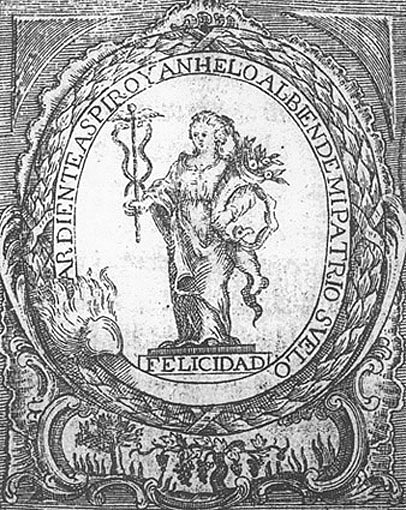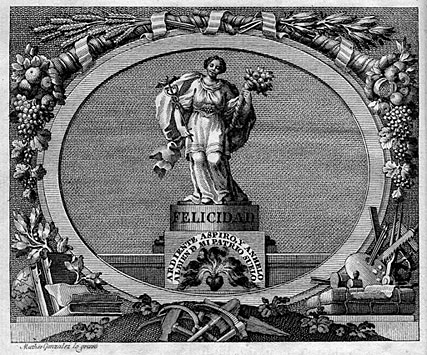The piece of the month of February 2007
business OF THE ROYAL TUDELAN SOCIETY OF THE DESIRES OF THE PUBLIC GOOD (Mateo González, 1779)
Pablo Guijarro Salvador
Chair of Navarrese Heritage and Art
The Economic Societies of Friends of the Country were one of the main channels of penetration and diffusion of the Enlightenment in Spain. The idea originated in the famous Sociedad Bascongada, promoted by the Count of Peñaflorida, authorized in 1765. Its success was such that Campomanes in his speech on the promotion of popular industry (1774) proposed the creation of similar institutions to collaborate with the government in its reform program. Formed by the educated classes and local leaders, their mission statement was to know the economic and social status of their territory, promote agriculture and industry, professionally educate peasants and artisans, attend to the poor, etc. From 1775 onwards, following the model of the one created in Madrid, numerous Societies were founded throughout the country.
One of these enlightened corporations was created in Tudela in 1778, under the name of Real Sociedad Tudelana de los Deseosos del Bien Público. This is the date of its official approval, since, in reality, since 1773 a dozen Tudelans had been meeting in gatherings, called conversations, around the figure of Francisco Magallón, V Marquis of San Adrián. The famous Marquis of San Adrián, portrayed years later by Goya, would also attend these gatherings as "student". The main figures of Tudela at the time joined the Economic Society, including the bishops of the new diocese. Numerous activities were developed in its bosom, most of them of subject theoretical. Among the most outstanding was the construction and establishment of the Royal House of Mercy, a task entrusted to it by its founder, María Huarte. In spite of the gradual decadence into which it entered after a few years, the Society managed to recover and experienced a period of splendor during the 19th century, managing to survive until its present precarious state.
All the Societies of Friends of the Country have in their statutes an epigraph dedicated to the business, formed by a symbolic image accompanied by a nickname or motto that summarizes the meaning of the composition. In that of Tudela, the degree scroll IX of its statutes reads as follows:
"It has been chosen for business of the Society a medal in which happiness is represented, in the form of a venerable matron standing, with the caduceus in the right hand, and in the left hand the cornucopia, symbol of abundance, with a registration on the base or pedestal of this figure, which says: Happiness. A heart will be placed underneath, exhaling lively and peaceful flames with this letter:
Ardent I aspire, and yearn
to the good of my homeland.
It alludes to the fact that the main aim of the Society is to banish idleness, to benefit the fields and promote industry, mother of abundance, intimately united with happiness".
Following these instructions, a first design was made, which appears engraved in the History and Statutes of the Society, published in Pamplona in 1778 (fig. 1). Its author is unknown, although it may well have been a local silversmith, the class of the artist who would take on this subject of commissions until the art of engraving was developed at the Academy. Clearly inspired by Ripa's allegory of happiness, a hieratic and almost frontal matron, dressed in white, holds in her left hand the cornucopia and in her right hand the caduceus, symbol of abundance and riches, and the second of peace, virtue and wisdom. He steps on a minimal pedestal on which the word happiness is inscribed. The figure is framed by a double oval, the outer one as a laurel wreath, and the inner one with the flaming heart exhaling the motto of the Society. In the lower part, rudimentarily composed, an olive tree, a vine and what could be some ears of corn. The whole design is finished on the outside with a rockery decoration.

Engraving of the cover of Historia y estatutos de la Sociedad de los Deseosos del Bien Público (1778).
Tudelana de los Deseosos del Bien Público (1778)
The leave quality of this first design made a bad impression on the members: "everyone disliked the plate and for the next printing I think the artist will change," said one of them. It appeared on no less than the cover of the first publication of the new Society, which was being sent to those prominent people who were wanted to swell the list of members. Consequently, they commissioned a new design to the engraver Mateo González. An indisputable figure of the Zaragozan engraving of the time, he already had experience in this subject of emblematic compositions, since he had made the business of the Real Sociedad Económica Aragonesa (1777). For the city of Tudela, years later he would make a plate with Saint Anne in her baldachin.
In this second version (fig. 2), the matron adopts a more lively posture, with her attire revealing the Anatomy and her mantle fluttering. She naturally carries the cornucopia and the caduceus, and stands on a double pedestal, one with the word happiness and the other with the flaming heart and the motto of the Society. All this is framed by a smooth oval, which in its upper part holds a decorative border formed by cornucopias, ears of wheat, olive branches and bunches of grapes, reference letter to the riches of the Tudela countryside, which will be the object of the work of the Friends of the Country. In the lower left part, some books would recall their intellectual work and the globe would allude to the totality and universality of knowledge and knowledge. The instruments on the lower right symbolize the industry and commerce that the Society would be responsible for promoting: the saw and the artisan's mallet, and the bundle the commercial exchanges. In addition, a palette and brushes, and the square and compass allude to the painting and drawing classes that many Societies started up to educate the working class . However, the Tudelana did not create its drawing school until well into the 19th century. Finally, in the foreground, at the bottom, a series of farm implements are arranged on a small mound, something for which Mateo González was inspired by the emblem he had made for the Sociedad Aragonesa.

Engraving by Mateo González (1779)
With its business the Tudela Society wanted to represent the intentions of progress, happiness and service to the public good that guided its work. These are the same objectives that were proposed by the numerous Economic Societies that were created throughout Spain, hence the motto and some of the symbols are repeated in the companies of many of them. This one by Mateo González for that of Tudela will appear after the preliminaries in the Memoirs of the Society, published in 1787, a work in which its members made known its first years of activity.
bibliography:
CASTRO ÁLAVA, José Ramón, Los Amigos del País y su ambiente histórico, N.T.C.P., nº 150, Pamplona, Diputación Foral de Navarra, 1972.
ENCISO RECIO, Luis Miguel, "Las Sociedades Económicas de Amigos del País", in Historia de España (founded by Ramón Menéndez Pidal). La época de la Ilustración, vol. El Estado y la Cultura (1759-1808), Madrid, Espasa-Calpe, 1987, pp. 13-56.
GONZÁLEZ ECHEGARAY, Carlos, Los emblemas de las Sociedades Económicas de Amigos del País, Madrid, Real Sociedad Bascongada de los Amigos del País, 1999.
Historia y Estatutos de la Sociedad Tudelana de los Deseosos del Bien Público, Pamplona, Oficina de José Miguel de Ezquerro, 1778.
MARTÍ, Marc, "Emblems and mottos of the Economic Societies of Friends of the Country. Análisis de un speech de intenciones", in Brocar, nº 19 (1995), pp. 189-209.
ROY SINUSÍA, Luis, El arte del grabado en Zaragoza durante los siglos XVIII y XIX, Zaragoza, Institución Fernando el Católico, 2006.
